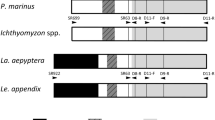Summary
The sequence homology in the single copy DNA of sea stars has been measured. Labeled single copy DNA fromPisaster ochraceus was reannealed with excess genomic DNA fromP. brevispinus, Evasterias troschelii, Pycnopodia helianthoides, Solaster stimpsoni, andDermasterias imbricata. Reassociation reactions were performed under two criteria of salt and temperature. The extent of reassociation and thermal denaturation characteristics of hybrid single copy DNA molecules follow classical taxonomic lines.P. brevispinus DNA contains essentially all of the sequences present inP. ochraceus single copy tracer whileEvasterias andPycnopodia DNAs contain 52% and 46% of such sequences respectively. Reciprocal reassociation reactions with labeledEvasterias single copy DNA confirm the amount and fidelity of the sequence homology. There is a small definite reaction of uncertain homology betweenP. ochraceus single copy DNA andSolaster orDermasterias DNA. SimilarlySolaster DNA contains sequences homologous to approximately 18% ofDermasterias unique DNA. The thermal denaturation temperatures of heteroduplexes indicate that the generaPisaster andEvasterias diverged shortly after the divergence of the subfamilies Pycnopodiinae and Asteriinae. The twoPisaster species diverged more recently, probably in the most recent quarter of the interval since the separation of the generaPisaster andEvasterias.
Similar content being viewed by others
References
Angerer RC, Davidson EH, Britten RJ (1976) Chromosoma 56:213–226
Belford HS, Thompson NF (1977) Carnegie Institute of Washington Yearbook 76:246–252
Bonner TI, Heinemann R, Todaro GJ (1980) Nature 286:420–423
Britten RJ, Graham DE, Neufeld BR (1974) In: Grossman L, and Moldave K (eds) Methods in Enzymology Vol 29, Part E Academic Press, New York, pp 363–418
Britten RJ, Cetta A, Davidson EH (1978) Cell 15:1175–1186
Brykov VA, Volfson VG, Vorobev VI (1979) Chromosoma 74:105–124
Commerford SL (1971) Biochemistry 10:1993–1999
Chamberlin ME, Galau GA, Britten RJ, Davidson EH (1978) Nucleic Acids Res 5:2073–2094
Davidson EH, Hough BR, Amenson CS, Britten RJ (1973) J Mol Biol 77:1–24
Eden FC, Hendrick JP, Gottlieb SS (1978) Biochemistry 17:5113–5121
Fraser A, Gomez J, Hartwick EB, Smith MJ (1981) Can J Zool (in press)
Galau GA, Chamberlin ME, Hough BR, Britten RJ, Davidson EH (1976) In: Ayala FJ (ed) Molecular Evolution, Sinauer Press, Sunderland Mass, pp200–225
Hall TJ, Grula JW, Davidson EH, Britten RJ (1980) J Mol Evol 16:95–110
Hanham AF, Smith MJ (1980) Comp Biochem Physiol 65B:333–338
Harpold MM, Craig SP (1978) Differentiation 10:7–11
Hayes FN, Lilly EH, Ratliff RL, Smith DA, Williams DL (1970) Biopolymers 9:1105–1117
Hinegardner R (1974) Comp Biochem Physiol 49B:219–226
Jukes TH (1980) Science 210:973–978
Kleene K, Humphreys T (1977) Cell 12:143–155
Kohne DE (1970) Quart Rev Biophysics 3:327–375
Laird CD, McConaughy BL, McCarthy BJ (1968) Nature 224:149–154
Murray MG, Thompson WF (1977) Carnegie Institution of Washington Yearbook 76:259–262
Noll H (1967) Nature 215:360–363
Pearson W, Davidson EH, Britten RJ (1977) Nucleic Acids Res 4:1727–1737
Perler F, Efstratiadis A, Lomedico P, Gilbert H, Kolodner R, Dodgson J (1980) Cell 20:555–566
Rice NR (1974) Carnegie Institution of Washington Yearbook 73:1098–1102
Roberts RJ, Wilson GA, Young FE (1977) Nature 265:82–84
Schmidtke J, Schmitt E, Matzke E, Engel W (1979) Chromosoma 75:185–198
Sibley CG, Ahlquist JE (1980) Second International Congress of Systematics and Evolutionary Biology, Vancouver, Canada, p 35
Smith MJ, Britten RJ, Davidson EH (1975) Proc Natl Acad Sci USA 72:4805–4809
Smith MJ, Boal R (1978) Can J Biochem 56:1048–1054
Smith MJ, Lui A, Gibson KK, Etzkorn JK (1980) Can J Biochem 58:352–360
Spencer WK, Wright CW (1966) In: Moore RC (ed) Treatise on Invertebrate Paleontology. Part U Echinodermata 3. Vol 1. The Geological Society of America Inc. and the University of Kansas Press
Stein DB, Thompson WF (1977) Carnegie Institute of Washington Yearbook 76:252–255
Studier FW (1965) J Mol Biol 11:373–390
Wilson AC, Carlson SS, White TJ (1977) Annu Rev Biochem 46:573–639
Author information
Authors and Affiliations
Rights and permissions
About this article
Cite this article
Smith, M.J., Nicholson, R., Stuerzl, M. et al. Single copy DNA homology in sea stars. J Mol Evol 18, 92–101 (1982). https://doi.org/10.1007/BF01810827
Received:
Revised:
Issue Date:
DOI: https://doi.org/10.1007/BF01810827




